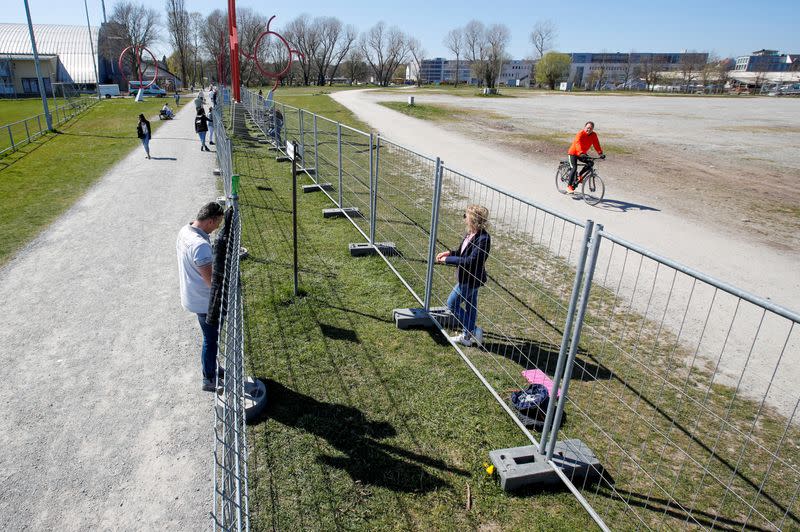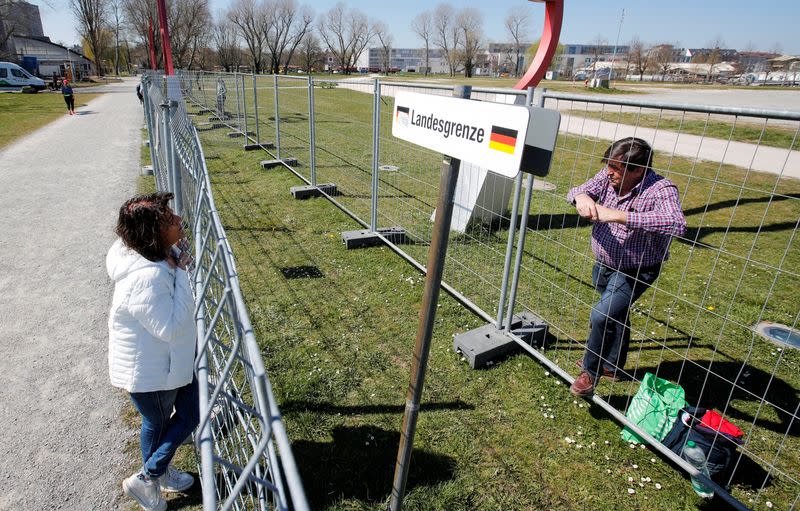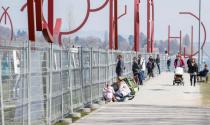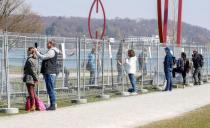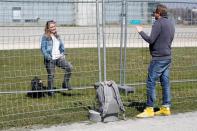Coronavirus divides lovers, friends at Swiss-German border fences
By John Miller
KREUZLINGEN, Switzerland (Reuters) - Constance, Germany, and Kreuzlingen, Switzerland, are divided cities these days, with a strip of grass and two fences separating them after the countries closed their borders to slow the spread of the coronavirus.
In a park on Lake Constance's shoreline residents of both cities normally move freely across an invisible line marking where one nation ends and the other begins. But everything has changed: Most Germans cannot come to Switzerland, most Swiss are barred from Germany.
On Sunday, lovers, brothers and sisters, parents and their children, and old friends pressed against the chain links in the spring sunshine, just close enough to say "I love you", too far apart to touch.
"This is our only chance to stand across from each other, face-to-face," said Jean-Pierre Walter, a Swiss who drove an hour from Zurich to see his German partner, Maja Bulic. "We can at least speak to each other. That's something."
For weeks, they have telephoned or spoken over FaceTime. But fiber optic is no substitute for flesh and blood.
"At some point, you have to see somebody in person," said Bulic, who drove 2-1/2 hours from near Heidelberg. "It's difficult, but I know one day it will be different."
This is a coronavirus no-man's land. It traces the route of a barbed wire-topped barrier that split Switzerland and Germany during World War Two and that was removed long ago.
The fences have become a meeting point for people divided by the epidemic - and a reminder of its disruption for Europeans accustomed to traveling where they please. Switzerland is not in the European Union, but agreements allow Swiss and the bloc's citizens to travel virtually unfettered, in normal times.
As the coronavirus spread -- it has killed 559 people and infected 21,100 in Switzerland, while in Germany the toll is 1,342 dead and nearly 92,000 infected -- the governments clamped down on border traffic.
Currently, those Swiss and Germans with cross-border jobs can go back and forth. For nearly everybody else, it's forbidden.
The fence went up in mid-March as a single layer.
This week, officials added a second, since people were passing beers, playing cards and kissing through the chain links - hardly the required two-metre (six-foot) separation.
Kreuzlingen officials said of the decision that too many people were not obeying the rules.
Swiss border police, reinforced by the Swiss Army, patrol the Swiss side. An occasional German federal police squad car makes the rounds just opposite.
THROWN CHOCOLATE BARS
While those at the fences said they largely accepted personal deprivations to slow the spread of the disease, some observed that the power of states to halt activities once taken for granted was intimidating.
Germans, for whom a wall long divided East from West, said they never imagined another one in Europe.
"It's like being in jail," said Veronica Campanile, a Constance resident meeting friends from the Kreuzlingen side.
Dominik Loroff drove three hours from Munich to meet Michele Graf-Ludin, from Winterthur, 50 minutes away in Switzerland. They had read about the fence, how it had become a magnet for those trapped on different sides of the coronavirus divide.
They had hoped to touch but settled for sharing chocolate bars thrown quickly across when border police weren't looking.
"It's sad, when you consider the fate of individuals," Loroff said. "If it was still just one fence, it would be OK. The second fence is tough."
(Reporting by John Miller and Arnd Wiegmann in Kreuzlingen and Kirsti Knolle in Vienna; Editing by Frances Kerry)

